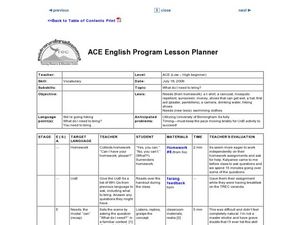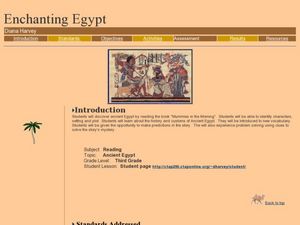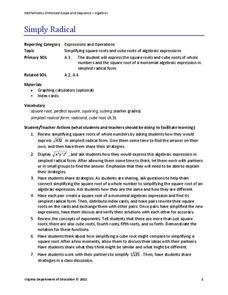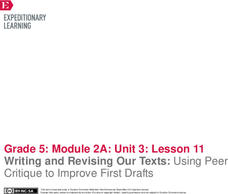Purdue University
Getting the Dirt on Decomposition
Sometimes science requires getting a little dirty. A hands-on activity explores the idea of decomposition by building a compost structure. Using red worms and dirt, individuals build and collect data on the rate of decomposition. The...
American Museum of Natural History
Around the World with DNA
DNA analysis could be what saves some animals from extinction. An interactive lesson shows learners how DNA information proves variation among animals of the same species and how stakeholders use that information to make decisions. Easy...
NASA
Exploring the Moon
Can plants grow on the moon? The second instructional activity in a five-part series has pupils explore the resources available on the moon to determine if plant life is possible. They use lava rocks as their soil and draw conclusions...
American Chemical Society
The Periodic Table and Transuranium Elements
The periodic table has so much more to it than meets the uninformed eye. An inquiry-based lesson leads learners through the history of the discovery of several transuranium elements. They then use informational resources to build a...
American Chemical Society
The Water Cycle
Bring the water cycle into the classroom without the mess. Learners build a model of the water cycle using everyday materials. They observe the process of evaporation and condensation and relate their observations to the larger scale...
Center for History Education
Native American Gender Roles in Maryland
Toss gender roles out the window—some societies lived in a world where women not only possessed the family wealth but also were the farmers and butchers. Many Native American societies had more gender equity than European societies....
Anti-Defamation League
Harriet Tubman on the $20 Bill: The Power of Symbols
How important are symbols and symbolic gestures in society? Middle schoolers have an opportunity to analyze the importance of symbols on American currency with a lesson plan that investigates the controversies surrounding redesigning the...
Curated OER
Notetaking Procedures
Sixth graders explore notetaking procedures. In this study skills lesson, 6th graders use text organizers to categorize information. Students select textbook sections and write headings, subheadings, and summary phrases for each section.
Curated OER
Food Poems and Base Words
Students identify base words to decipher new vocabulary. In this vocabulary lesson, students complete a graphic organizer while reading about food and nutrition. Students discuss simple and complex endings when using words.
Curated OER
What Do I Need to Bring?
Students build their vocabulary skills by answering the question; "What do need to bring?" In this ESL lesson, students create several different graphic organizers to help them categorize vocabulary concepts. Then they read a handout,...
Curated OER
Genetics and Heredity
Students explore genetics and heredity. They study meiosis and view videos and create vocabulary flashcards. They create a graphic organizer that compares and contrasts sexual and asexual reproduction in each of the six kingdoms. They...
Curated OER
What's the Best Age to Retire?
In this retirement worksheet, students read a 7-paragraph article regarding retirement ages around the world. Students respond to 7 graphic organizer, matching, and short answer questions regarding the article. Vocabulary words and...
Curated OER
Mars 500: Would You Go?
In this Mars worksheet, students read a 7-paragraph article and respond to 8 graphic organizer, matching, and short answer questions. Vocabulary words and definitions are included.
Curated OER
Writing A Storybook
Learners create a storybook using vocabulary from the topic "urban and rural life". They write about past events in a children's story. They present their story to the class at an author's tea.
Teach Engineering
Lighting in My Classroom Survey
How much energy does it take to light a room? Class members calculate the total wattage it takes to light the classroom. Through calculations, responsible scientists determine the cost of energy for the year, then figure out how much...
Curated OER
Enchanting Egypt
After reading the Magic Tree House book Mummies in the Morning, learners talk about Ancient Egypt. They identify the plot, characters, setting, etc., explore vocabulary terms, and construct a pyramid. This will motivate your class to...
Virginia Department of Education
Rational Speed Matching
Ready, set, go! Individuals practice converting rational numbers between fractions, decimals, and percents. A speed game has teams match the three forms of rational numbers on a number line.
Curated OER
Capitals, Designers & Common Fashion Terms
The importance of fashion on society is identified and new vocabulary associated with fashion is defined. Using the internet, your class will identify the major fashion capitals of the world and write about one. To end the lesson, they...
Curated OER
Mr. Lincoln's Whiskers
Learn about the events that helped shape the United States of America. Elementary schoolers explore the Civil War with six different activities. Each activity has a different focus: literature connections, primary sources, vocabulary,...
Virginia Department of Education
Simply Radical
Simplifying is radical, dude! After reviewing how to simplify square roots of whole numbers, scholars consider how to simplify square roots of algebraic monomials. Also taken under consideration is how to simplify cube roots of whole...
Curated OER
Scientific Method
Students explore the scientific method. In this scientific method lesson, students use information gathered from a "Seed Dispersal" lab done previously to complete a worksheet listing the steps of the scientific method.
EngageNY
Writing and Revising Our Texts: Using Peer Critique to Improve First Drafts
Mail me a postcard. Individuals design a postcard to show what Meg Lowman from The Most Beautiful Roof in the
World might have written to her friends at home. They then continue to work on writing a science journal entry.
Curated OER
Literature Circle Preparation
The secret to a successful literature circle discussion is preparation. Readers prepare for such a discussion by completing a two-page worksheet that asks them to summarize the text, record new words, ask and answer questions, and draw a...
Curated OER
Using Amino Acid Sequences to Show Evolutionary Relationships
Junior biologists compare the amino acid sequences from fragments of five different globin molecules. They count the letter differences between each species pair. They construct a graphic representation of the evolutionary relationships...

























